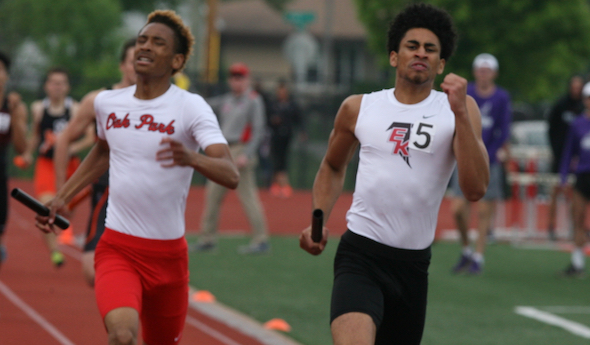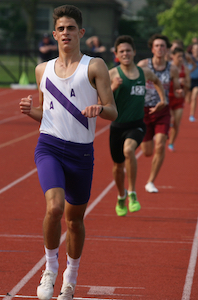
East Kentwood Adds Perfection to Streak
June 1, 2019
By Dean Holzwarth
Special for Second Half
KENTWOOD – A hard pounding rain began to fall shortly after the East Kentwood boys track & field team reached the podium.
It was only fitting, as the Falcons reigned once again.
East Kentwood completed a three-peat Saturday at home in the MHSAA Lower Peninsula Division 1 Finals.
The Falcons scored 63.5 points in winning the Finals for the eighth time in the last 11 years. They also won three consecutive championships from 2009-11.
Ann Arbor Pioneer placed runner-up with 43 points.
“An amazing group of kids that just fought and fought and fought all day,” East Kentwood coach Dave Emeott said.
The Falcons did so despite winning only three events. East Kentwood claimed top honors in the 800 and 1,600 relays, while Stephan Bracey won the long jump (24-1.25).
“We only had three firsts today, and everything else was a battle and they did it,” Emeott said. “They stepped up in every opportunity they had, and they hung together. They trusted each other as teammates and came out on top at the end of the day. I’m just so proud of this team.”
Junior Michael Osteno helped the winning 1,600 relay team as he joined Elijah Ealy, Junior Hie and Jeremiah Applewhite to clock a 3:18.54.
“It’s something you dream about, running on this track and winning another state championship,” Osteno said. “Going back-to-back-to-back was the goal today and we wanted to finish, execute and give an elite mindset to get that third one.
“We came out and did what we’ve been doing all season, and when it came time to step up like we knew other teams were going to do, that’s what we did.”
The victory also culminated a perfect season. The Falcons went undefeated in duals, in the conference championship and also won their Regional.
“At the beginning of the season the seniors talked about what we wanted to accomplish, and they talked about a perfect season,” Emeott said. “That hadn’t happened in the last couple years. They wanted to be perfect, and that’s hard to do, especially in the O-K Red, but they stepped up and did it.
“We have a lot of young athletes, and some of them sacrificed for the team. They did four or three events. The other day I said that I didn’t know why I was so stressed because I have nothing to be stressed about, because they are so nice and so great.”
 Ann Arbor Pioneer finished second for the second straight year and was led by senior standout Nick Foster, who capped an illustrious prep career with wins in the 1,600 (4:12.32) and 3,200 (9:08.55).
Ann Arbor Pioneer finished second for the second straight year and was led by senior standout Nick Foster, who capped an illustrious prep career with wins in the 1,600 (4:12.32) and 3,200 (9:08.55).
“This is the last time wearing a Pioneer uniform, and it’s been a crazy last four years,” Foster said. “I just wanted to go out with a bang, and our team got second. I’m going to miss all these guys, and it’s pretty awesome to go out like this.”
Foster competed in four events, and actually got a little rest because of delays due to inclement weather.
“I knew it was going to be a similar challenge, and I knew I was stronger coming in,” Foster said. “This year there was more of a goal of winning all the events and trying to place in the 1,600 relay.
“There was a lot of pressure coming back, but I knew I was strong enough to do all these events and I tried to take one race at a time. Mother Nature helped with the delays.”
Foster’s final race was the 3,200, which he won by a little more than two seconds ahead of Alpena’s Aden Smith.
“My third one, that was the toughest,” Foster said. “I knew I had to stay close, and I had confidence in my finish.”
Lansing Waverly’s Keshaun Harris repeated in the 300 hurdles (37.75) and also won the 110 hurdles (13.98) after placing runner-up last season.
Rockford’s Noah Stallworth also took home a pair of titles in the 100 (10.76) and 200 (21.64).
The following also collected individual championships: Grand Blanc’s Ethan Vargo (high jump), Brownstown Woodhaven’s Clarence Corbett (shot put), Alpena’s Gabe Bullis (pole vault), Alpena’s Eli Winter (discus), Novi’s Miles Brown (800) and Westland John Glenn’s James Flournoy (400).
PHOTOS: (Top) East Kentwood stays just ahead of Oak Park to claim a relay championship Saturday in LP Division 1. (Middle) Ann Arbor Pioneer's Nick Foster leads the way. (Photos by Carter Sherline. Click to see more from RunMichigan.com.)

Track Gaining Speed Toward Future with Electronic Starting Devices
By
Steve Vedder
Special for MHSAA.com
May 23, 2023
Aubrey Greenfield thinks it might be the perfect time to reevaluate 130 years of tradition.
For a number of reasons, from technical to personal, the Oxford senior sprinter believes it makes sense for the crack of a starting pistol to be eliminated from high school track meets.
Because track meets would benefit in various ways from lowering costs to easier setup at meets to the human factor of competitors not having to flinch at the crack of a pistol shot, Greenfield believes the sport has a chance to embrace new technology – electronic starting devices (ESD).
In essence, an ESD replaces the starting pistol with a light flash, tone sound or both to begin a race.
"High school sports should put the athlete first," Greenfield said. "We should promote sports, and eliminating starting pistols promotes health in terms of PTSD or trauma for athletes and spectators and that would be good. I would like to think people would say that's a good idea."
In fact, Greenfield would go as far as to say if there was not an implementation of electronic starting devices, many of her teammates would have considered giving up the sport.
"If it's something that helps us compete safely, we're all for it," she said.
Greenfield's opinion apparently is spreading. Michigan High School Athletic Association senior assistant director Cody Inglis said the use of ESD makes it both affordable for meet starters and sensible for athletes and fans to rethink the use of starting pistols. While the MHSAA is not mandating electronic starting devices, it does promote the use of what Inglis calls "emerging technology." He notes that ESD are becoming the norm for organizations such as USA Track & Field, the NCAA and an increasing number of high schools.
 "I think we have to embrace new technology, and we think this will be something that takes hold," Inglis said.
"I think we have to embrace new technology, and we think this will be something that takes hold," Inglis said.
A key part of embracing ESD is the human element. The tragic Oxford High School shooting Nov. 30, 2021, that took the lives of four students while injuring seven others should not be relived even for a fleeting instance at a high school sporting event. Oxford athletic director Tony DeMare said the school began using ESD at every meet, including the MHSAA Lower Peninsula Division 1 Finals last June. He said that decision was embraced by virtually all schools Oxford encountered.
"We were very convinced that the alternative (of ESD) would promote a healthy attitude," DeMare said. "We were overwhelmed with the positive response. If a school was on the fence about it or might not be for it, I think we've started to see the tide turn in favor of people willing to listen and learn about electronic starting devices."
Inglis said the MHSAA is acutely aware of what the crack of a starting pistol can mean to athletes and fans.
"It's unimaginable what Oxford went through, and this is a small way we can help," he said. "We look at a (starting pistol) and think, ‘Could we do something else?’ It's a way of helping to solve a problem."
Over the last several years, the MHSAA has embraced finding an alternative to starting pistols. Inglis noted the discussion started with the cost and diminishing availability of 32-caliber ammunition that meet starters use. A box of ammunition, if it can be found, is around $75 a box.
In addition to cost, there is potential damage from excessive exposure to 150-plus decibels of sound generated by the traditional 32-caliber blanks. Medical studies show damage to ears caused by decibel levels above 120 dB.
The tragedy at Oxford accelerated the conversation.
Inglis said the cost of ESD can be likened to a school sinking money into artificial surfaces at football fields. Yes, there is a great cost at first, but over time money is ultimately saved. An ESD system itself ranges between $200 and $500. Speakers also may need to be purchased, but with ESD starting events like the 800 and 1,600-meter relays positioned near the outside lanes 8, 7, 6 and 5 would result in improved hearing by athletes at the start of a race.
There is one challenge with ESD that track administrators are working to overcome – lighting conditions that lessen the ability to see the ESD’s LED light or strobe when the button is pressed by a starter to begin a race. But that vision difficulty resulting from clear blue skies and backgrounds of setting suns can be substantially improved by incorporating a black background with an ESD – something as simple as a starter holding up black cardboard behind the lighting mechanism at the start of an event.
Inglis said when all factors are considered, the use of ESD makes sense.
 "With the climate we live in nowadays, no lookalike guns is good," he said. "We're not mandating this. But people are saying this is affordable."
"With the climate we live in nowadays, no lookalike guns is good," he said. "We're not mandating this. But people are saying this is affordable."
While switching to ESD would break 130 years of tradition, the timing could be a step forward, said Jeff Hollobaugh, co-author of the book "The Fleet Feet of Spring: Michigan's High School State Championships in Track & Field." He said while no definitive answer is possible, it's likely starting pistols were used at the inaugural state meet at the Jackson Fairgounds in 1895. The meet, which included events like tossing a 16-pound shot put, bike races and a 100-meter sprint, was sponsored by the Michigan Interscholastic Athletic Association (a predecessor to the MHSAA) and comprised mostly of the state's larger schools.
Hollobaugh's sentiments echo what many involved in today's high school track & field believe in terms of making a transition from starting pistols to electronic starting devices.
"It's a change, not necessarily good or bad, just different," he said. "It's not a drastic change, but it will take some getting used to. But it is the future. In the end, we'll all be fine."
DeMare believes the future of high school track will definitely include ESD.
"Our desire is that the practicality and sensibility of this will overcome the alternative," he said. "I think we'll see the automation and electronics taking hold of certain elements in track, and people will embrace it."
PHOTOS (Top) Runners watch official Bertha Smiley as they prepare to begin a race during last season's Lower Peninsula Division 1 Finals at Rockford. (Middle) An electronic starting device provided by VS Athletics was used to start those races. (Below) Smiley sets to begin an event. (Photos provided by David Kuderka/VS Athletics.)

